What kings wore from Tudor times to now
From Henry VIII to today's King Charles III, how a king dresses has for centuries been a window into his personality and priorities, writes Cath Pound.It is now only days until the Coronation of King Charles III, and the outfit he will be wearing has finally been announced. The King will be dressed in layers of glittering robes, including a shimmering gold-sleeved coat called the Supertunica for the crowning. The robe was made for George V in 1911, and has been worn in every coronation since, including that of Elizabeth II. On top of the Supertunica will be a floor-length cloak named the Imperial Mantle, or Robe Royal, which was made for George IV in 1821. More like this: - How to watch the Coronation in the US - How the late Queen became a style icon - The art that captured a royal icon Given the lavish nature of such garments, it is perhaps unsurprising that it has been tradition for recent monarchs to reuse them, although they have usually had a new coronation sword belt and glove made. However, King Charles has decided to re-use the belt and glove made for his grandfather, George VI. It may seem a relatively small gesture, given the opulence of every other garment, yet in declining to have something unnecessarily made he is very publicly declaring that the commitment he showed to sustainability as Prince of Wales will continue when he is king.The then-Prince Charles is depicted in a 1980 portrait by Bryan Organ, which features in the NPG book Charles III: The Making of a King (Credit: National Portrait Gallery, London)The Coronation will not be the first time King Charles III has very publicly indicated the type of monarch he intends to be via his clothing choices. In Bryan Organ's 1980 portrait of the then Prince of Wales, painted at the time of his engagement to Lady Diana Spencer, the then Prince of Wales is dressed in his polo clothes and sits with his legs crossed in a relatively relaxed pose. "The idea of informality and being relaxed was quite deliberate. He was probably thinking this is the image he wants to project, it's not the typical image of an heir to the throne, but something showing him more as an independent person in his own right with his own interests," says Alison Smith, chief curator of the National Portrait Gallery, which has just published Charles III: The Making of a King to tie in with the Coronation. As an unusually well-educated King with an interest in history and the history of art, King Charles will no doubt be well aware how the clothing choices of his predecessors have been used to interpret their personalities and priorities as kings, and will know that his own choices have, and will, come under equal scrutiny.Henry VIII in his finery, portrayed in the iconic portrait by the workshop of Hans Holbein the Younger, sends a message of power (Credit: Alamy)It was Henry VIII who first realised the potential of fashion as a political tool. His father, Henry VII, had won the throne by defeating Richard III at the Battle of Bosworth, the culmination of the bitter Wars of the Roses, and as such Henry VIII was "still very keen to stress the legitimacy of the Tudor's right to rule. If you're at the top you need to assert that visually, and he marked out particular textiles as being exclusively royal," historian Maria Hayward, an expert on Tudor and Stuart fashion, tells BBC Culture. These were cloth of gold, the colour purple and sable fur, although they would have been reserved for special occasions. An added impetus was the break with Rome, following his divorce from Anne Boleyn, which left England in the religious minority. Dressed in his finery in the iconic portrait by Hans Holbein the Younger, destroyed by fire in 1698 but still widely known due to the multiple copies made and disseminated at the time, Henry VIII was determined to send out the message that he was a powerful king, entirely the equal to his European contemporaries. By the time of Charles I, "there was a move away from cloth of gold except for very, very formal occasions," says Hayward. "Satin is now the favoured fabric, invariably in those lovely pastel colours we associate with the Van Dyck portraits." However, this less ostentatious style certainly did not coincide with a more democratic approach to rule. And we all know how that ended up.George I, depicted here by Wilhelm Lafontaine, was a low-profile King (Credit: Royal Collection Trust / His Majesty King Charles III 2023)Following his father's execution, the future Charles II was forced into exile for many years. After the Restoration he was determined to stress the continuity of monarchy. In the coronation portrait by John Michael Wright, "he is wearing his parliament robes over the silver tissue suit, which is the Order of the Garter suit, and that is intrinsically backward looking, almost as if the Commonwealth didn't happen," says Hayward. During his time in exile awarding the Order of the Garter had been Charles's only m

It is now only days until the Coronation of King Charles III, and the outfit he will be wearing has finally been announced. The King will be dressed in layers of glittering robes, including a shimmering gold-sleeved coat called the Supertunica for the crowning. The robe was made for George V in 1911, and has been worn in every coronation since, including that of Elizabeth II. On top of the Supertunica will be a floor-length cloak named the Imperial Mantle, or Robe Royal, which was made for George IV in 1821.
More like this:
- How to watch the Coronation in the US
- How the late Queen became a style icon
- The art that captured a royal icon
Given the lavish nature of such garments, it is perhaps unsurprising that it has been tradition for recent monarchs to reuse them, although they have usually had a new coronation sword belt and glove made. However, King Charles has decided to re-use the belt and glove made for his grandfather, George VI. It may seem a relatively small gesture, given the opulence of every other garment, yet in declining to have something unnecessarily made he is very publicly declaring that the commitment he showed to sustainability as Prince of Wales will continue when he is king.
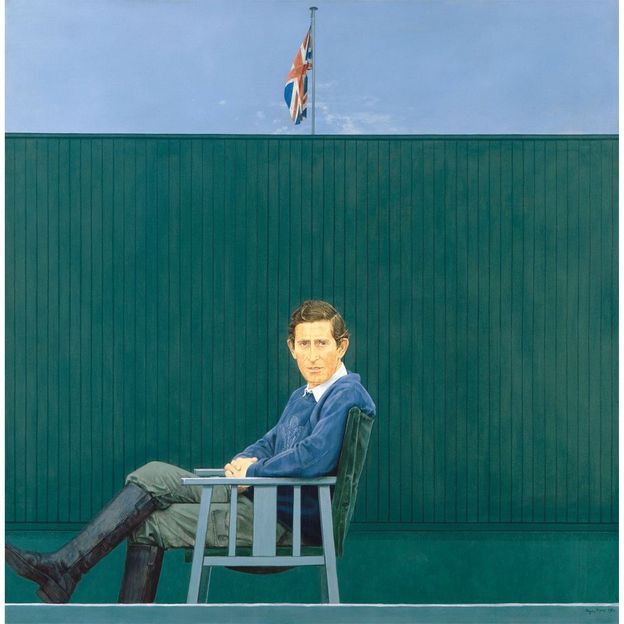
The then-Prince Charles is depicted in a 1980 portrait by Bryan Organ, which features in the NPG book Charles III: The Making of a King (Credit: National Portrait Gallery, London)
The Coronation will not be the first time King Charles III has very publicly indicated the type of monarch he intends to be via his clothing choices. In Bryan Organ's 1980 portrait of the then Prince of Wales, painted at the time of his engagement to Lady Diana Spencer, the then Prince of Wales is dressed in his polo clothes and sits with his legs crossed in a relatively relaxed pose. "The idea of informality and being relaxed was quite deliberate. He was probably thinking this is the image he wants to project, it's not the typical image of an heir to the throne, but something showing him more as an independent person in his own right with his own interests," says Alison Smith, chief curator of the National Portrait Gallery, which has just published Charles III: The Making of a King to tie in with the Coronation.
As an unusually well-educated King with an interest in history and the history of art, King Charles will no doubt be well aware how the clothing choices of his predecessors have been used to interpret their personalities and priorities as kings, and will know that his own choices have, and will, come under equal scrutiny.
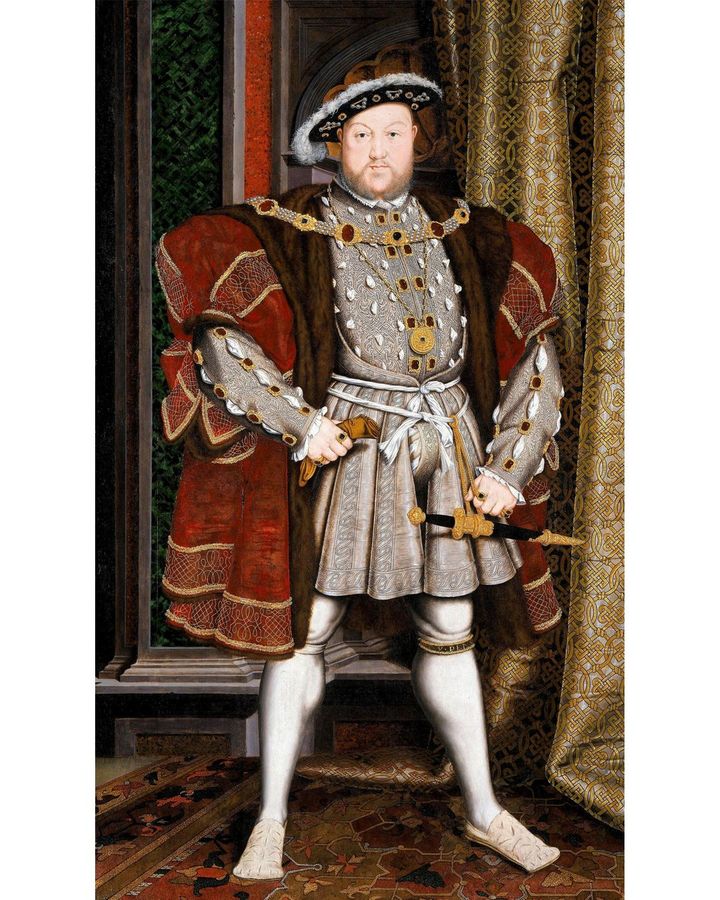
Henry VIII in his finery, portrayed in the iconic portrait by the workshop of Hans Holbein the Younger, sends a message of power (Credit: Alamy)
It was Henry VIII who first realised the potential of fashion as a political tool. His father, Henry VII, had won the throne by defeating Richard III at the Battle of Bosworth, the culmination of the bitter Wars of the Roses, and as such Henry VIII was "still very keen to stress the legitimacy of the Tudor's right to rule. If you're at the top you need to assert that visually, and he marked out particular textiles as being exclusively royal," historian Maria Hayward, an expert on Tudor and Stuart fashion, tells BBC Culture. These were cloth of gold, the colour purple and sable fur, although they would have been reserved for special occasions.
An added impetus was the break with Rome, following his divorce from Anne Boleyn, which left England in the religious minority. Dressed in his finery in the iconic portrait by Hans Holbein the Younger, destroyed by fire in 1698 but still widely known due to the multiple copies made and disseminated at the time, Henry VIII was determined to send out the message that he was a powerful king, entirely the equal to his European contemporaries.
By the time of Charles I, "there was a move away from cloth of gold except for very, very formal occasions," says Hayward. "Satin is now the favoured fabric, invariably in those lovely pastel colours we associate with the Van Dyck portraits." However, this less ostentatious style certainly did not coincide with a more democratic approach to rule. And we all know how that ended up.
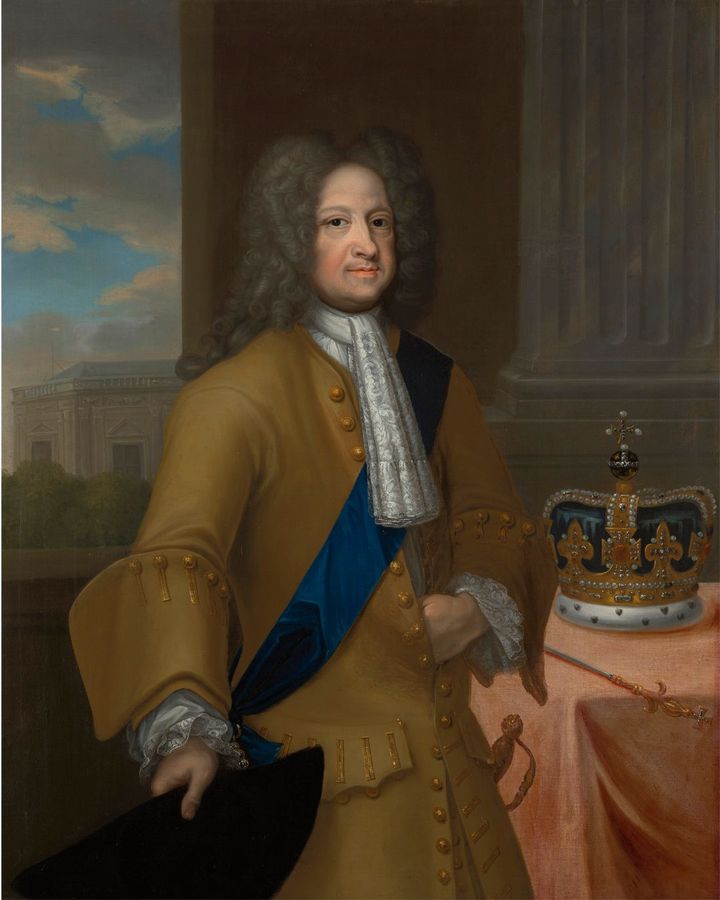
George I, depicted here by Wilhelm Lafontaine, was a low-profile King (Credit: Royal Collection Trust / His Majesty King Charles III 2023)
Following his father's execution, the future Charles II was forced into exile for many years. After the Restoration he was determined to stress the continuity of monarchy. In the coronation portrait by John Michael Wright, "he is wearing his parliament robes over the silver tissue suit, which is the Order of the Garter suit, and that is intrinsically backward looking, almost as if the Commonwealth didn't happen," says Hayward. During his time in exile awarding the Order of the Garter had been Charles's only means of securing bonds of loyalty and he swiftly restored the honour after his return.
In private however, Charles II preferred a more low-key form of dress. "He liked a degree of informality, and I think in part that must have come from is time in exile. It was helpful to be incognito. If people recognised him, and didn't acclaim him, it would have been a bit embarrassing. But it also suited his personality. He preferred to do business in an informal, private setting," says Hayward.
When it comes to the Hanoverians, their contrasting, conflicting personalities are most certainly evidenced in their dress sense.
George I "was not interested in fashion at all," says Anna Reynolds, curator of Style and Society: Dressing the Georgians, currently showing at the Queen's Gallery, Buckingham Palace. A portrait by Georg Wilhelm Lafontaine sees him looking decidedly un-regal in a plain wool coat. However, as he was an elderly German man who didn't speak much English, was only 52nd in line to the throne, and only king because he was the nearest Protestant candidate according to the Act of Settlement, it probably suited him to keep a low profile.
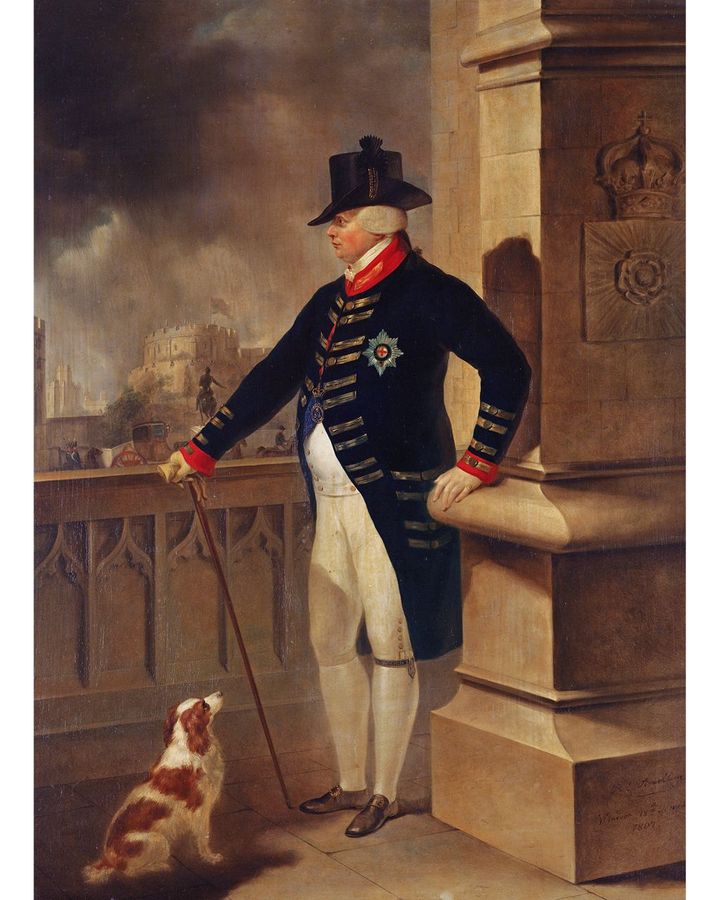
George III devised the Windsor Uniform, worn by the King along with other Royals (Credit: Royal Collection Trust /His Majesty King Charles III 2023)
"He left all the pageantry and splendour to his son, the Prince of Wales, the future George II, who ran a sort of rival court at Leicester House," says Reynolds. Always richly dressed he was nicknamed "dapper George," by one courtier.
In addition to fashion, he was "also almost obsessionally interested in uniforms, insignia and protocols of rank. He always wore the Order of the Garter for example," says Reynolds. The last monarch to lead his troops into battle, and proud of his image as a soldier king, George II was also responsible for introducing uniforms for the army and navy.
He wears it well
The pendulum swung back once again with George III who, it was said, dressed so unassumingly he could mingle in the crowd without being noticed. Although Reynolds thinks that might be something of an exaggeration, she does think the stories are a part of this characterisation of him as a very down-to-earth king who in the prints of the time was depicted as Farmer George.
George III was "very frugal," says Reynolds, and "not really interested in his appearance at all." Although she notes that he did "understand the need to dress for the role whenever necessary, so he wears the Coronation robes with great swagger in Ramsay's portrait."
"He was always most at ease in uniforms of office," she says. So much so that he devised his own Windsor Uniform, influenced by the European trend for civilian uniforms which had been introduced by Louis XIV as a means of indicating a close connection with the monarch. Consisting of a dark blue coat with red collar and cuffs and pale breeches, "it was his favourite style of dress for the last 30 years of his life," says Reynolds.
Initially only worn by members of the Royal Family, it was gradually adopted by senior attendants in the royal household, and by the aristocracy. "It became a demonstration of a close relationship with the king but also a public demonstration of support for him during his difficult periods, including when he was ill. At a thanksgiving service to celebrate his return to health many were wearing the uniform," says Reynolds.
A version is still worn by members of the Royal Family for events at Windsor, and it has influenced the uniforms of visitor services staff at Windsor and in London.
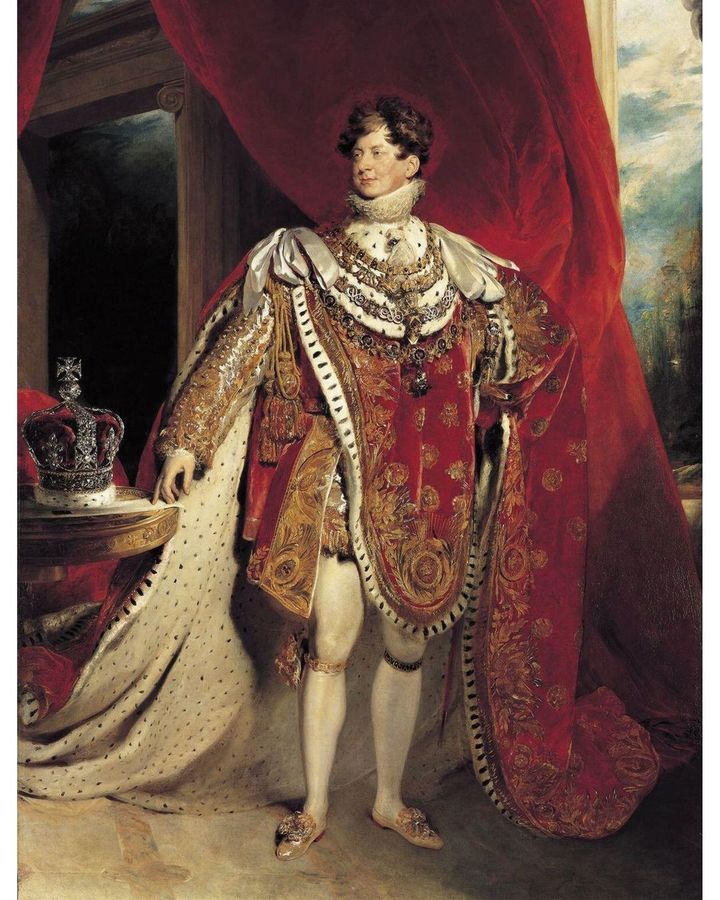
George lV, portrayed here in an 1821 portrait by Sir Thomas Lawrence, was an enthusiastic follower of fashion (Credit: Alamy)
In marked contrast to his father, the future George IV was an enthusiastic follower of fashion who for a while had the famed English dandy, Beau Brummell, as his style guru. "In portraits he's very much as the forefront of fashion," says Reynolds. He favoured well-cut quality fabrics, a style which became particularly associated with England and which, for the first time, actually influenced what was worn in France.
His keen interest in fashion extended to the Tudor and Stuart inspired outfit he designed for his coronation, the most extravagant in British history. It included a coronation mantle made of red velvet, lined with ermine, and ornately embroidered which was so enormously heavy it took eight train bearers to carry it. Unfortunately for George IV he had to wear it during a heatwave in July. "The whole ensemble almost caused him to faint and apparently he used 19 handkerchiefs during the homage alone," says Reynolds.
Equally renowned for his flamboyant style was Edward VIII. He loved colour and pattern and wasn't afraid to make a bold statement, combining clashing patterns with great elan and wearing traditional British fabrics such as tweed in unconventional colours like cinnamon. Rejecting the buttoned-up formality of his childhood he was famed for a casual style he labelled "dress soft". At the same time, no one could wear a suit quite like him. "I was in fact produced as a leader of fashion, with the clothiers as my showmen and the world as my audience," he famously proclaimed.
George VI was a very different man, who of course never thought he was going to be King. After painting him in the robes of the Order of the Garter, Sir Gerald Kelly commented on the problem of "persuading this modest man to strike a decorative pose". It seemed he was far more comfortable without the trappings of royalty. And perhaps his unostentatious, reassuring style was exactly what the country needed after the turmoil of the abdication and the threat of war with Germany.
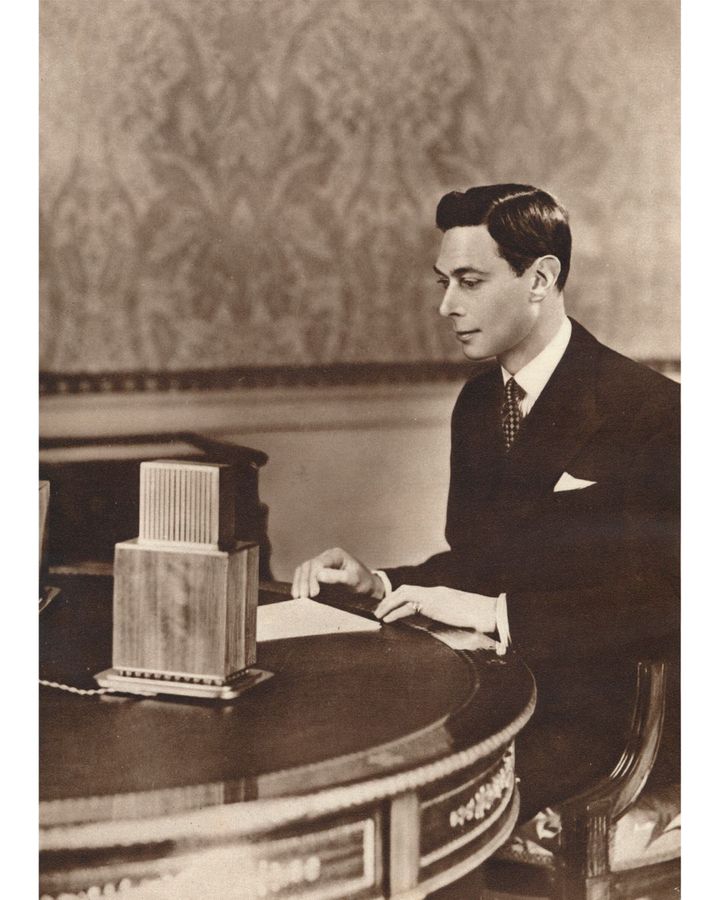
George VI’s personal style was reassuringly unshowy at a time of turmoil under the threat of war and following the abdication (Credit: Getty Images)
King Charles combines his great uncle's love of fashion with his grandfather's commitment to duty. In the years since the Organ portrait, his style has been defined by beautifully cut, double-breasted suits and a certain way with accessories. "It's his signature style, consistent across the years, always looking immaculately turned out," says Smith. In an understated, very British way, he clearly cares deeply about the way he looks. "I mind about detail and colour and things like that," he told Vogue editor Edward Enninful in a 2020 interview.
But he is also an activist royal, committed to sustainability and the protection of the environment, who has refused, sometimes controversially, to keep his views to himself. What he wears, and how he wears it, reveals his concerns in multiple ways.
The humble blue cornflower can frequently be seen in his buttonhole, and it appears in a particularly striking photographic portrait by Nadav Kander from 2013. Now endangered in its natural habitat, the flower draws attention to his environmental concerns.
Clearly aware of the devastating carbon footprint of the fashion industry, Charles has taken steps to influence the production methods of his own suppliers. He has remained loyal to certain makers for years, but around 30 years ago he began insisting that to earn his Royal Warrant they had to conform to specific environmental requirements. Although some protested, they all eventually concurred.
Once items are in his wardrobe, he loathes the thought of ever throwing them away. "I'd rather have them maintained, even patched if necessary, than to abandon them," he told Enninful. And he is certainly not the kind of man who feels the need to have something newly made for every special occasion. The Anderson and Sheppard Morning suit he wore for the Duke and Duchess of Sussex's wedding dates back to the mid-1980s. He has a tweed coat that he has worn in four separate decades.
And he puts his commitment to environment and sustainability into practical actions. As Prince of Wales, Charles founded the Campaign for Wool, promoting wool as an inherently natural, renewable and biodegradable fibre. At Dumfries House he started a training scheme in high-end fashion and sewing skills which developed into the Modern Artisan, a range of luxury sustainable clothing for men and women created in partnership with Yoox Net-a-Porter and The Prince's Foundation.
It remains to be seen whether as king he will have time to be so actively involved in such initiatives himself. Or if he, and his advisors, will feel it would be inappropriate to do so. However, by wearing quality clothing made in an environmentally friendly manner, preferring to have items repaired rather than discarded, and wearing the same items on repeat, King Charles will continue to be a highly visual ambassador for sustainable fashion and the environmental causes to which he has long been committed.
Style and Society: Dressing the Georgians is at The Queen’s Gallery, Buckingham Palace until 8 October.
Charles III: The Making of a King by Dr Alison Smith is published by NPG.
If you would like to comment on this story or anything else you have seen on BBC Culture, head over to our Facebook page or message us on Twitter.
And if you liked this story, sign up for the weekly bbc.com features newsletter, called The Essential List. A handpicked selection of stories from BBC Future, Culture, Worklife and Travel, delivered to your inbox every Friday.












